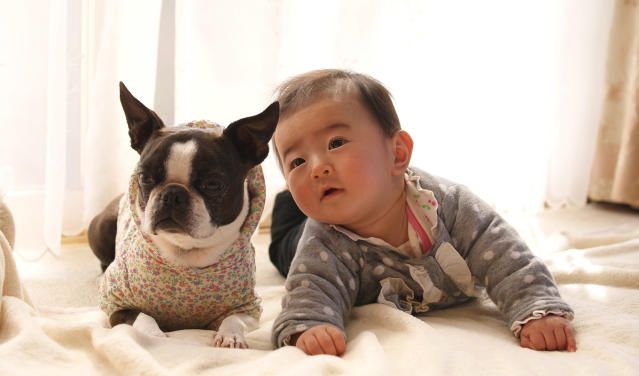When introducing a new puppy to your dog, it may take up to one month for them to fully accept each other’s position in the pack. It is important to commit to this process and not panic.
To introduce them, bring the dogs together in a meeting spot, allowing them to greet each other naturally while keeping the leashes slack. Expect sniffing, circling, playing, or even ignoring each other as they establish their relationship. Making introductions on neutral territory with both dogs on leads can help them get used to each other’s smells.
Overall, taking it slow and supervised is key to helping your older dog accept the new puppy.
1. Understanding The Importance Of Proper Introductions
Introducing a new puppy to your dog is an exciting but delicate process. It is crucial to understand the importance of proper introductions in order to set the foundation for a harmonious relationship between your existing dog and the new addition to your family. Proper introductions not only ensure a smooth transition for both dogs, but they also help prevent any potential conflicts or behavioral issues down the line.
1.1 The Importance Of Introducing A New Puppy To Your Dog
Introducing a new puppy to your dog is not as simple as just bringing them together and hoping for the best. Dogs are highly social animals with hierarchical instincts, and introducing a new member to the pack requires a strategic approach. By properly introducing your puppy to your dog, you are fostering a positive and healthy relationship from the start.
When bringing a new puppy home, it’s essential to provide a structured environment where your existing dog feels secure and respected as the leader of the pack. This helps avoid feelings of jealousy, possessiveness, and aggression towards the newcomer. Additionally, proper introductions create a strong bond between the dogs, enhancing their socialization skills and overall well-being.
1.2 The Impact Of Improper Introductions
Improper introductions can have negative consequences for both your existing dog and the new puppy. Rushing the process or neglecting to establish the proper hierarchy can lead to tension, dominance issues, and territorial conflicts. This can result in aggressive behavior, fights, and even injuries to either dog.
Without proper introductions, dogs may develop negative associations and fear towards each other, making it difficult to build trust and create a harmonious household. It’s important to be patient and take the necessary steps to ensure a successful introduction, even if it means taking longer than expected.
1.3 Benefits Of Proper Introductions
| The Benefits of Proper Introductions: |
|---|
| 1. Promote positive bonding between your existing dog and the new puppy. |
| 2. Establish a clear hierarchy and reduce potential conflicts. |
| 3. Enhance socialization skills for both dogs. |
| 4. Create a harmonious household and minimize stress. |
| 5. Foster a lifelong companionship between your dogs. |
Overall, proper introductions play a crucial role in setting the tone for the relationship between your existing dog and the new puppy. By following a structured approach, you can ensure a smooth transition, reduce the likelihood of conflicts, and establish a strong bond between your furry family members.

Credit: www.yahoo.com
2. Steps For Introducing A New Puppy To Your Dog
Introducing a new puppy to your dog can be an exciting yet challenging experience. To ensure a smooth transition and a harmonious relationship between your furry friends, it’s important to follow a few essential steps. In this article, we will explore the process of introducing a new puppy to your dog, covering everything from making initial preparations to gradual integration and building positive associations.
2.1 Making Initial Preparations
Before bringing your new puppy home, it’s crucial to make the necessary preparations to set both dogs up for success. Here are some key steps to take:
- Ensure your current dog is up to date on vaccinations and flea/tick preventive treatments.
- Prepare a dedicated space for the new puppy, such as a crate or a separate area in your home.
- Stock up on essential supplies, including food, water bowls, toys, and bedding.
- Consider getting a baby gate or playpen to create boundaries between the dogs at first.
2.2 Choosing The Right Meeting Spot
The location of the initial introduction between your dog and the new puppy can greatly influence the outcome. Follow these guidelines to select the ideal meeting spot:
- Choose a neutral territory that neither dog considers as their own territory.
- Avoid confined spaces that could trigger territorial behavior.
- Ensure the area is safe and free from distractions or hazards.
2.3 Techniques For Introducing The Dogs
The introduction itself requires careful management and techniques to establish a positive first meeting. Here are some effective strategies:
- Have separate handlers for each dog to maintain control and provide support.
- Keep the leashes loose to avoid tension and allow the dogs to interact naturally.
- Allow the dogs to sniff each other without interference, as this is their way of gathering information.
2.4 Common Behaviors To Expect During The Introduction
When introducing dogs, it’s crucial to understand common behaviors and reactions that may occur. Here are a few behaviors you can expect:
- Sniffing: Dogs rely heavily on scent, and sniffing is their primary way of gathering information about each other.
- Posturing: Dogs might display dominant or submissive postures to establish their role in the relationship.
- Playfulness: Some dogs may engage in play behavior, which is a positive sign of acceptance and comfort.
2.5 Supervising The Dogs’ Interactions
During the initial interactions, proper supervision is crucial to ensure a safe environment and prevent any negative incidents. Follow these guidelines:
- Stay calm and alert, ready to intervene if necessary.
- Observe the body language of both dogs for signs of stress, fear, or aggression.
- Redirect any unwanted behavior with positive reinforcement, such as treats or praise.
2.6 Gradual Integration And Building Positive Associations
The final step is gradually integrating the dogs and fostering positive associations. Here are some effective methods:
- Allow supervised playtime in a controlled environment.
- Offer rewards and treats for calm and appropriate behavior.
- Establish separate feeding areas to prevent resource guarding.
By following these steps, you can help your current dog and new puppy develop a strong bond and achieve a harmonious coexistence.
3. Tips For Helping An Older Dog Accept A New Puppy
Introducing a new puppy to an older dog can be an exciting but challenging process. Older dogs may feel stressed or overwhelmed by the presence of a new energetic pup. However, with some patience and the right approach, you can help your older dog accept and even enjoy having a new puppy around. Here are five tips to ensure a smooth transition:
3.1 Taking Things Slowly And On Neutral Territory
One essential tip is to take things slowly when introducing your older dog to the new puppy. Start by making introductions on neutral territory, such as a park or a friend’s backyard. This helps prevent any territorial behavior from your older dog and allows them to feel more comfortable.
Keep both dogs on leads at a safe distance, allowing them to observe and sniff each other from a distance. Gradually decrease the distance over time as both dogs become more relaxed and curious. Remember to never force interaction between the two dogs and give them space if they need it.
3.2 Allowing Natural Sniffing And Getting Used To Smells
Sniffing is a crucial part of dogs’ communication and getting used to each other’s smells. During the introduction, allow both dogs to explore and sniff each other. This helps them become familiar with each other and establishes a scent bond.
As a pet owner, you should resist the urge to interfere or redirect their attention during this process. Let them interact naturally and create their own boundaries. It might take some time for the dogs to feel comfortable around each other, so be patient and let them take their time.
3.3 Providing Separate Spaces And Individual Attention
To ensure a harmonious coexistence, it’s crucial to provide both the older dog and the new puppy with their own separate spaces. This allows them to have their own safe zones and retreat when they need a break.
Make sure each dog has its own bed, crate, or designated area where they can relax without feeling threatened. Additionally, it’s vital to give both dogs individual attention and one-on-one time with you. This helps them feel loved and secure, preventing any jealousy or rivalry from developing.
3.4 Ensuring A Balanced, Structured Environment
A balanced, structured environment is essential for creating a positive atmosphere for both dogs. Establish consistent house rules and boundaries that apply to both dogs. This helps set clear expectations for behavior and prevents any potential conflict.
Provide regular exercise, mental stimulation, and consistent leadership to both dogs. This helps in establishing a healthy pack dynamic and reduces any competitive behavior between them. Dogs thrive on structure, so maintaining a routine and sticking to it will greatly benefit their acceptance of each other.
3.5 Seeking Professional Guidance If Necessary
In some cases, introducing a new puppy to an older dog might require professional guidance. If you’re facing challenges or notice aggressive behavior, it’s important to consult a certified dog behaviorist or trainer.
They can assess the situation and provide personalized advice and training methods tailored to your specific needs. Seeking professional help ensures the safety and happiness of both dogs and helps you address any underlying issues that might hinder their acceptance of each other.

Credit: www.amazon.com

Credit: www.ebay.com
Frequently Asked Questions For Cesar Millan Introducing A New Puppy To Your Dog
How Long Does It Take For A Dog To Accept A New Puppy?
It can take up to a month for a dog to accept a new puppy. When introducing them, keep the dogs on separate leashes and let them greet each other. Be patient and allow them to sniff, circle, play, or ignore each other.
Take things slow and introduce them on neutral territory.
How Do You Introduce A New Puppy To An Established Dog?
To introduce a new puppy to an established dog, bring them to a neutral meeting spot separately. Allow them to greet each other with loose leashes. It’s normal for them to sniff, circle, play, urinate, or ignore each other. Take it slow and let them get used to each other’s smells.
How Do You Get An Older Dog To Accept A New Puppy?
To get an older dog to accept a new puppy, introduce them on neutral territory and supervised. Keep both dogs on leads, allowing them to sniff and get used to each other’s smells. Take it slow and be patient.
How Soon Should You Introduce Your Puppy To Other Dogs?
It is recommended to introduce your puppy to other dogs once they have received all their necessary vaccinations, typically around 12-16 weeks of age. This allows them to socialize and learn proper dog behavior while minimizing the risk of infections.
Conclusion
Bringing a new puppy into your home can be an exciting but challenging time for both you and your existing dog. However, with patience and the right approach, you can successfully introduce them and set the foundation for a harmonious relationship.
Remember to take things slow, allow them to interact on neutral ground, and supervise their initial interactions. Give them space to sniff, circle, and play, allowing them to establish their own dynamics. With time and proper guidance, your dogs will learn to accept and love their new furry sibling.
Happy puppy parenting!



